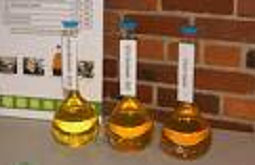Renewable energy biodiesel - ethanol

In the world of renewable energy it’s not uncommon for natural allies to turn into unlikely foes. In order to support a particular point of view, an advocate of one form of renewable energy will often take issue with some other form of renewable energy and adopt the arguments of those who seek to discredit all forms of renewable energy. For example, I was reading a website that was enumerating the benefits of a vertical axis wind turbine by calling it ‘bird and bat’ safe, thereby implying that horizontal wind turbines are not bird and bat safe. The bird and bat issue is a specious argument used by people who oppose all forms of wind turbines because of aesthetic reasons, not because of their concern for wildlife. So adopting and embracing an argument from a group that is likely to oppose vertical axis turbines as well is not a wise decision. In other words, the enemy of your enemy is not necessarily your friend.
I’ve noticed the same phenomenon with biofuels. I’ve witnessed several biodiesel proponents compare biodiesel not only to conventional diesel fuel and gasoline, but also take the opportunity to criticize ethanol, a fuel you’d think they’d be somewhat sympathetic toward since biodiesel has a lot in common with ethanol. Both biodiesel and ethanol use biomass as a feedstock and both are working to gain acceptance. They are better for the environment than petroleum-based fuels that release carbon to the atmosphere that has been buried for millions of years. When it comes to biofuels, it’s not wise for advocates of either fuel to circle the wagons and then point their guns inward at each other. I’m sure biofuel opponents of all stripes must become giddy when they see such self-defeating tactics.
The U.S. uses approximately 140 billion gallons of gasoline per year. Most of that could be replaced by ethanol with only minor changes to the majority of the U.S. automotive fleet. I’m only considering the demand and not the supply infrastructure. But since demand drives supply more than the reverse, it’s an important consideration. Cars manufactured in the last 15 years have incorporated fuel injection systems whose air-to-fuel ratio can be adjusted to a much greater degree than their predecessors that used carburetors. There are kits available to make a non flex-fuel vehicle compatible with E85 ethanol. The materials used in modern automotive fuel systems are compatible with ethanol because it’s been used as a gasoline additive for a long time. So, while it may not be as easy as flipping a switch, the existing automotive fleet conversion to ethanol is an economically viable scenario. As more flex-fuel vehicles begin to comprise the U.S. automotive fleet, it will become even easier to convert to ethanol-based fuel.
Diesel fuel demand is 60 billion gallons per year in the U.S. and is used primarily in the trucking industry. This means that U.S. gasoline demand is more than twice diesel demand. However, in Europe the picture is nearly reversed. They use twice as much diesel as they do gasoline, primarily because a high percentage of cars have diesel engines because automotive emissions regulations are not as strict as they are in the U.S.. Diesel contains about 17% more thermal energy than gasoline per gallon, and can be combusted at higher temperatures, making it possible to convert more of that energy into horsepower, so it’s not unusual to get about 25% better fuel economy out of diesel engine than you can out of a gasoline engine. Since diesel has historically been priced similarly to gasoline, this advantage hasn’t gone unnoticed in the U.S. and its annual demand growth has been outpacing that of gasoline.
But diesel doesn’t burn as cleanly as gasoline which is a disadvantage. Ethanol has a lower thermal energy content, about 45% less per gallon than diesel, but it’s also priced lower and burns cleaner than either gasoline or diesel. In addition, if you could assure its widespread availability, new automotive engines could eventually take advantage of higher compression ratios to help make up for some of what ethanol lacks in thermal energy with increased thermal energy conversion efficiency afforded with a higher compression ratio.
Any copying and distributing the material of Ukrainian Biofuel Portal
without active hyperlink is stricly prohibited !
Link to this news: Renewable energy biodiesel - ethanol
Copy & Paste This Code to your website:
Views: 3090 Added: 15-01-2009
Average Rating:
Renewable energy biodiesel - ethanol








